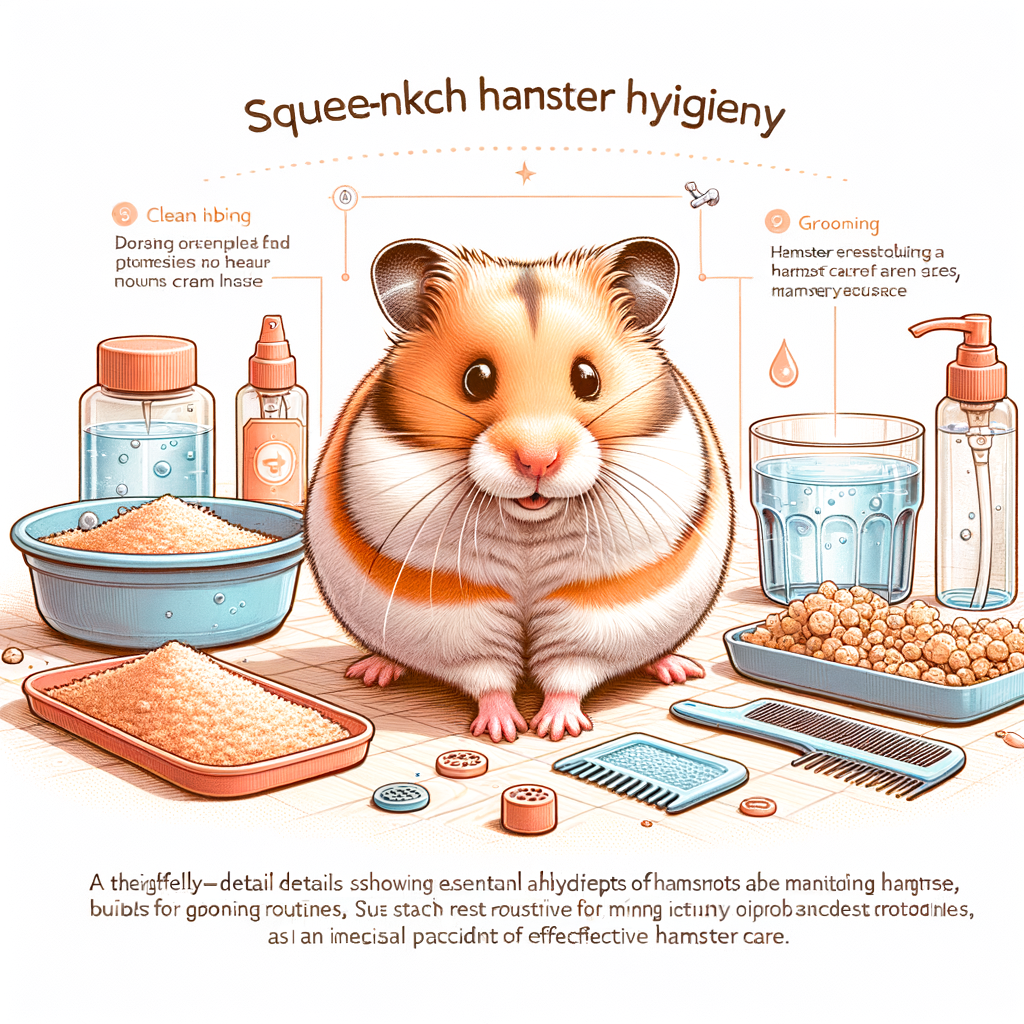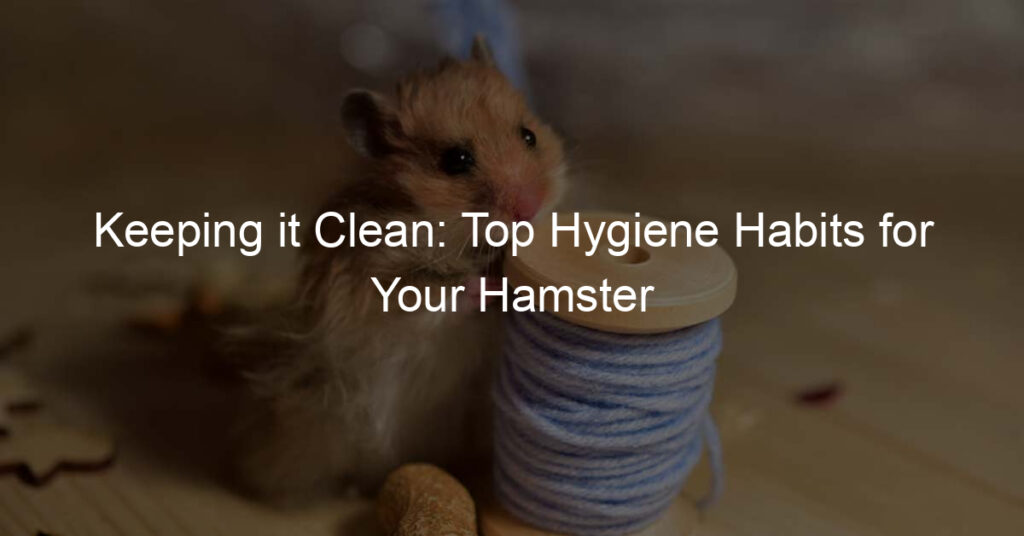
Introduction to Hamster Hygiene
Hamsters are adorable, fluffy, and make great companions. But just like us, they also need to maintain good hygiene to stay healthy and happy. In this section, we’ll delve into the importance of hamster cleanliness and understand their hygiene habits.
- The Importance of Hamster Cleanliness
- Understanding the Hygiene Habits of Hamsters
Keeping your hamster clean is not just about having a fresh-smelling pet. It’s about ensuring their overall health and well-being. A clean hamster is a happy hamster. When hamsters are clean, they are less likely to develop skin problems or infections. Plus, a clean hamster habitat reduces the risk of unpleasant odors and the spread of bacteria and parasites. Therefore, maintaining your hamster’s cleanliness is crucial for their health and your comfort.
Hamsters are naturally clean animals. They groom themselves regularly, much like cats do. They use their paws to clean their fur and face. However, they also rely on their human caretakers to provide a clean living environment. This includes regular cage cleaning, providing fresh bedding, and ensuring their food and water sources are clean. Understanding these habits can help you provide the best care for your furry friend.
In the following sections, we will explore best practices for hamster hygiene, share some practical hygiene tips, and look at some case studies to better understand the hygiene habits of hamsters. By the end of this article, you’ll be well-equipped to provide your hamster with the clean and healthy environment they deserve.
Best Practices for Hamster Hygiene
Keeping your hamster clean is crucial for its health and happiness. This section will guide you through the best practices for maintaining your hamster’s hygiene.
Hamster Grooming Practices
Grooming is an essential part of a hamster’s hygiene routine. It helps keep their fur clean and free from parasites. Let’s explore how often you should groom your hamster and the tools required for the same.
- How often should you groom your hamster?
- Tools needed for hamster grooming
Hamsters are naturally clean animals and often groom themselves. However, it’s recommended to check their fur and skin once a week. If your hamster has long hair, like a Teddy Bear or Syrian hamster, you may need to groom it more frequently, perhaps every few days, to prevent its fur from matting.
When grooming your hamster, you’ll need a few essential tools. These include a small, soft-bristle brush for their fur, a toothpick to clean their teeth, and a pair of blunt-ended scissors for trimming long hair. Always remember to be gentle as hamsters have delicate skin.
By following these grooming practices, you can ensure your hamster stays clean and healthy. Remember, a well-groomed hamster is a happy hamster!
Maintaining Hamster Hygiene
Keeping your hamster clean is not just about making them look good, it’s also about ensuring their health and happiness. There are two key areas to focus on when it comes to maintaining hamster hygiene: regular cleaning of their habitat and proper disposal of their waste.
- Regular Cleaning of Hamster Habitat
Hamsters are clean animals by nature, but they still rely on their human caregivers to keep their habitats clean and safe. A clean habitat is essential for preventing diseases and ensuring your hamster’s comfort.
It’s recommended to do a full clean of your hamster’s cage once a week. This involves removing all bedding and toys, scrubbing the cage with a pet-safe disinfectant, and then replacing the bedding and toys. However, it’s also important to spot clean daily. This means removing any soiled bedding or uneaten food every day to prevent bacteria build-up.
- Proper Disposal of Hamster Waste
Proper disposal of hamster waste is another crucial aspect of hamster hygiene. Hamster waste should be removed from the cage during your daily spot cleaning. It’s important to wear gloves during this process to protect yourself from potential diseases.
Once you’ve collected the waste, it should be disposed of in a sealed bag in your outside trash can. This prevents any odors from spreading in your home and also helps to keep your hamster’s habitat clean and fresh.
Remember, maintaining good hygiene practices for your hamster is not just about cleanliness, it’s also about ensuring their health and happiness. So, make sure to keep their habitat clean and dispose of their waste properly.
Hygiene Tips for Hamsters
Keeping your hamster clean is crucial for their health and happiness. Here are some essential tips to ensure your furry friend stays in the best possible condition.
Keeping Hamsters Clean
There are two main aspects to consider when it comes to keeping your hamster clean: proper handling and safe bathing techniques.
- Proper handling of hamsters
- Safe bathing techniques for hamsters
Hamsters are delicate creatures, and their hygiene starts with how you handle them. Always wash your hands before and after handling your hamster to prevent the spread of germs. Avoid handling them if you are sick or have been in contact with other animals. This can help prevent the transmission of diseases. Also, remember to handle your hamster gently to avoid causing them stress or injury.
Unlike many pets, hamsters clean themselves, so they rarely need baths. However, if your hamster gets into something sticky or dirty, you might need to give them a bath. Fill a shallow dish with warm (not hot) water, just enough to cover your hamster’s feet. Gently lower your hamster into the dish and use a soft toothbrush to clean their fur. Avoid getting water in their ears or eyes. Rinse them off with a little warm water and dry them thoroughly with a towel. Remember, never use human shampoo or soap on your hamster as it can irritate their skin.
By following these hygiene tips, you can help ensure your hamster stays healthy and happy. Remember, a clean hamster is a happy hamster!
Hamster Care: Beyond Cleanliness
While maintaining a clean habitat is essential for your hamster’s health, it’s not the only factor to consider. Proper care for these small, furry friends extends beyond cleanliness. Let’s delve into two other critical aspects of hamster care: proper feeding and nutrition, and providing mental stimulation.
- Proper Feeding and Nutrition
Just like humans, hamsters require a balanced diet to stay healthy. Their meals should include a mix of fruits, vegetables, and high-quality hamster pellets. Remember, not all human food is safe for hamsters. For instance, citrus fruits and onions can be harmful to them.
Hamsters are also prone to obesity, so it’s important to monitor their food intake. A typical hamster should consume about 10g of food per day. Overfeeding can lead to health issues such as diabetes and heart disease. Always ensure your hamster has access to fresh water, and clean their water bottle regularly to prevent the growth of bacteria.
- Providing Mental Stimulation for Hamsters
Hamsters are active and curious creatures. They need mental stimulation to prevent boredom and keep them happy. One way to provide this is through toys and exercise equipment. Hamster wheels, tunnels, and chew toys are all great options. You can also create a maze with cardboard for your hamster to explore.
Another way to stimulate your hamster’s mind is through interaction. Spend time playing with your hamster each day. This not only provides mental stimulation but also helps to build a bond between you and your pet.
In conclusion, hamster care involves more than just keeping their cage clean. A balanced diet and mental stimulation are equally important for your hamster’s overall wellbeing. By paying attention to these aspects, you can ensure your hamster leads a happy and healthy life.
Case Studies: Hygiene Habits of Hamsters
Let’s delve into the world of hamsters and explore two fascinating case studies that highlight the importance of hygiene in their lives.
- Case Study 1: The Impact of Cleanliness on Hamster Health
- Case Study 2: The Role of Grooming in Hamster Social Behavior
In this study, two groups of hamsters were observed over a period of six months. One group was kept in a clean environment, while the other was kept in a less clean environment. The results were quite revealing.
Hamsters in the clean environment had fewer health issues compared to those in the less clean environment. They had fewer instances of skin diseases, respiratory problems, and digestive issues. This case study clearly shows that cleanliness plays a crucial role in maintaining the health of hamsters.
| Environment | Health Issues |
|---|---|
| Clean | Fewer |
| Less Clean | More |
Hamsters are social animals and grooming plays a significant role in their social interactions. In this case study, hamsters that groomed regularly were observed to have more positive social interactions compared to those who did not.
Regularly groomed hamsters were more likely to be accepted by their peers, and they exhibited less aggressive behavior. This case study highlights the importance of grooming in hamster social behavior and underscores the need for regular grooming practices.
| Grooming Frequency | Social Acceptance |
|---|---|
| Regular | High |
| Irregular | Low |
These case studies underscore the importance of hygiene for hamsters, both for their health and social well-being. As hamster owners, it’s our responsibility to ensure that our furry friends have a clean environment and regular grooming.
Conclusion: The Importance of Cleanliness for Hamsters
As we wrap up our discussion on hamster hygiene, it’s crucial to remember that cleanliness is not just about keeping your hamster’s cage looking nice. It’s about ensuring the health and happiness of your furry friend. Let’s review some of the key takeaways and final thoughts on this important topic.
- Key takeaways on maintaining hamster hygiene
- Final thoughts on hamster care and cleanliness
Firstly, regular cleaning of your hamster’s cage is essential. As we’ve learned, a dirty cage can lead to diseases and infections, which can be harmful or even fatal to your pet. It’s recommended to do a full clean of the cage at least once a week, with spot cleaning done daily.
Secondly, grooming your hamster is also important. While hamsters are generally clean animals and groom themselves, they can sometimes need a little help. This is especially true for long-haired breeds, which can get bedding and other debris stuck in their fur.
Lastly, providing your hamster with a sand bath can help them keep their fur clean and free of oils. Remember to use sand specifically designed for hamsters, as other types can be too rough on their skin.
Caring for a hamster involves more than just feeding them and giving them water. It requires attention to their hygiene needs to ensure they live a long, healthy, and happy life. Cleanliness is a key part of this care.
Remember, a clean hamster is a happy hamster. By maintaining a clean environment and grooming your hamster as needed, you’re not only ensuring their physical health but also their mental well-being. After all, a clean and comfortable hamster is more likely to be active, playful, and sociable.
In conclusion, never underestimate the importance of cleanliness when it comes to caring for your hamster. It’s a crucial aspect of their care that can significantly impact their overall health and happiness.








